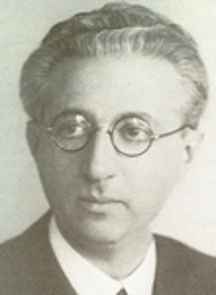A composer all his life, Ernest Kanitz was Professor in the Music School at the University of Southern California (USC) in the late 1940s-1950s, following forced emigration from Vienna in 1938. In December 1938 the local newspaper in Rock Hill, South Carolina announced his appointment at Winthrop College with the euphemism "he left Europe when Germany expanded " [see in Media].
Ernst Kanitz was born April 9, 1894 in Vienna. After studying law at the University of Vienna (J.D. 1918) [undertaken solely to satisfy his parents' wish that he "learn a useful occupation"; he studied with tutors and never actually went to a class], Ernst devoted himself between 1914 and 1920 to the systematic study of piano, theory and composition with Richard Heuberger (from 1912-1914) and Franz Schreker. Having turned 20 in 1914, Ernst tried twice to enlist in the army but was rejected due to his post-appendectomy "emaciated state" [family info]; he felt very bad about this.
In November 1918, his work "Heitere Ouvertüre op. 4" was performed by the Wiener Symphoniker conducted by Franz Schreker. That same year, at the home of a musical acquaintance, he met Gertrud Reif, whom he married on June 28, 1920. Since he was "a composer, and had no money," her father made Ernst sign a pre-nuptial agreement (Gertrude's father had little of his own wealth left, after WW I).
Early successes as composer [especially the premiere of the oratorio Das Hohelied (1921)] aided his musical career, which also led to teaching. From 1922 he was Professor of Theory and Analysis at the New Vienna Conservatory (Neues Wiener Konservatorium), and also taught numerous private students in composition). Kanitz conducted various student orchestras in Vienna, and in 1930 founded the Vienna Women's Chorus, with which he brought new choral music to the public in Vienna, Brno, Budapest and Paris [see in MEDIA]. The chorus lasted until Kanitz' emigration to the United States (by way of Holland; arrival was actually in New Jersey, on the ship Veendam on July 26, 1938 and the family never passed through Ellis Island, NY). Kanitz also composed original music for the modern dancer Lilian Harmel; her piece entitled "Magic Dance," to one of his compositions," was considered "the most interesting of her creations" by Dancing Times [see in MEDIA].
In the U.S. Dr. Kanitz, as he was always known, embarked on an extended teaching career, first at Winthrop College in Rock Hill, S.C. (1938-41), then as Head of the Music Department at Erskine College, Due West, S.C. (1941-44; his former student in Vienna, Felix Bauer, succeeded him at Erskine. Bauer's student-teacher relationship with Dr. Kanitz is discussed in Part 2 of Bauer's 1995 memoir housed in the Leo Baeck Institute in New York).
In 1945 Ernest Kanitz moved to Los Angeles, to a position at the University of Southern California. Initially he was to replace an ill colleague; he remained at USC teaching composition and counterpoint until his retirement in 1959 (returned as guest professor there in 1960-1961). In 1948 he published A Counterpoint Manual. From 1961-1964 he taught at Marymount College in Palos Verdes, California; then he devoted himself exclusively to private teaching and composing. His Concerto for Bassoon was premiered by the San Francisco Symphony April 8, 1964 (Josef Krips). His Symphony No. 2 was premiered Dec. 11-13, 1968, by the San Francisco Symphony (Josef Krips).
His activities had been severely restricted as early as 1967 by diminishing vision caused by glaucoma. Kanitz died in Menlo Park, CA in April 1978.
Papers are in the archives of the University of Southern California -- the collection has a finding aid, and the collection is cited in Sources Relating to the History of Émigré Musicians 1933-1950. Further papers are at the University of California, Riverside in Library Special Collections. A list of published works in the online library catalog, OCLC, appears in WorldCat; search "Ernest Kanitz."
The only available digitized recording of one of his pieces (partial) is at: http://youtube/fTwanjNuLHQ . See biographical sketch (.pdf file) attached under Media; open it in Adobe Acrobat & "rotate" in order to read.
Ernest Kanitz is the subject of chapters in Österreichs neue Musik nach 1945: Karl Schiske, ed. Markus Grassl, Reinhard Kapp, Eike Rathgeber (2008) and in Music And Dance In California And The West (1948).
Birth record appears in Wien (alle Bezirke), Geburtsanzeigen 1894 Records Nr. 0781-1263 (Apr.-Mai), Image #308 of 1171 (derived from record #901). Parents lived at Wien II, Nordbahnstrasse 44. Witnesses were [uncles] Dr. Julius Stricker and Emil Kanitz.
As did many ethnically Jewish individuals in Vienna, Ernst Kanitz "resigned from the Jewish faith" as a young man (genteam.at, Resignations from the Jewish Faith); he did not convert to Catholicism even though (as he put it decades later), that could have helped him get certain jobs.
Last Name Kanitz, First Name Ernst
Date of Birth 1894.04.09 (April 9, 1894), Wien II, Nordbahnstrasse 44
Profession stud.jur. (law student) [he never practiced law]
Leaving 1914, age 20, marital Status ledig
